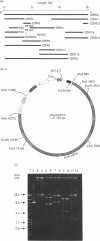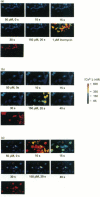Abstract
Malignant hyperthermia (MH), an inherited neuromuscular disease triggered by halogenated inhalational anaesthetics and skeletal-muscle relaxants, appears to be due to an alteration of intracellular Ca2+ homoeostasis. MH occurs in 1 out of 20,000 anaesthetized adults and is characterized by hypermetabolism, skeletal-muscle rigidity and elevation in body temperature, which is frequently fatal [MacLennan and Phillips (1992) Science 256, 789-794]. The defect responsible for the disease may lie within the mechanism controlling the release of Ca2+ from sarcoplasmic reticulum via the ryanodine-receptor (RYR) Ca2+ channel; in fact a point mutation in the RYR has been associated with MH in some human families, as well as in the MH-susceptible pig. To date, however, no direct evidence has been obtained demonstrating that the point mutation is both necessary and sufficient to cause functional alterations in RYR-mediated Ca2+ release. In the present report we show that the presence of the Arg-to-Cys point mutation in the recombinant RYR expressed in COS-7 transfected cells causes abnormal cytosolic Ca2+ transients in response to 4-chloro-m-cresol, an agent capable of eliciting in vitro contracture of MH-susceptible muscles.
Full text
PDF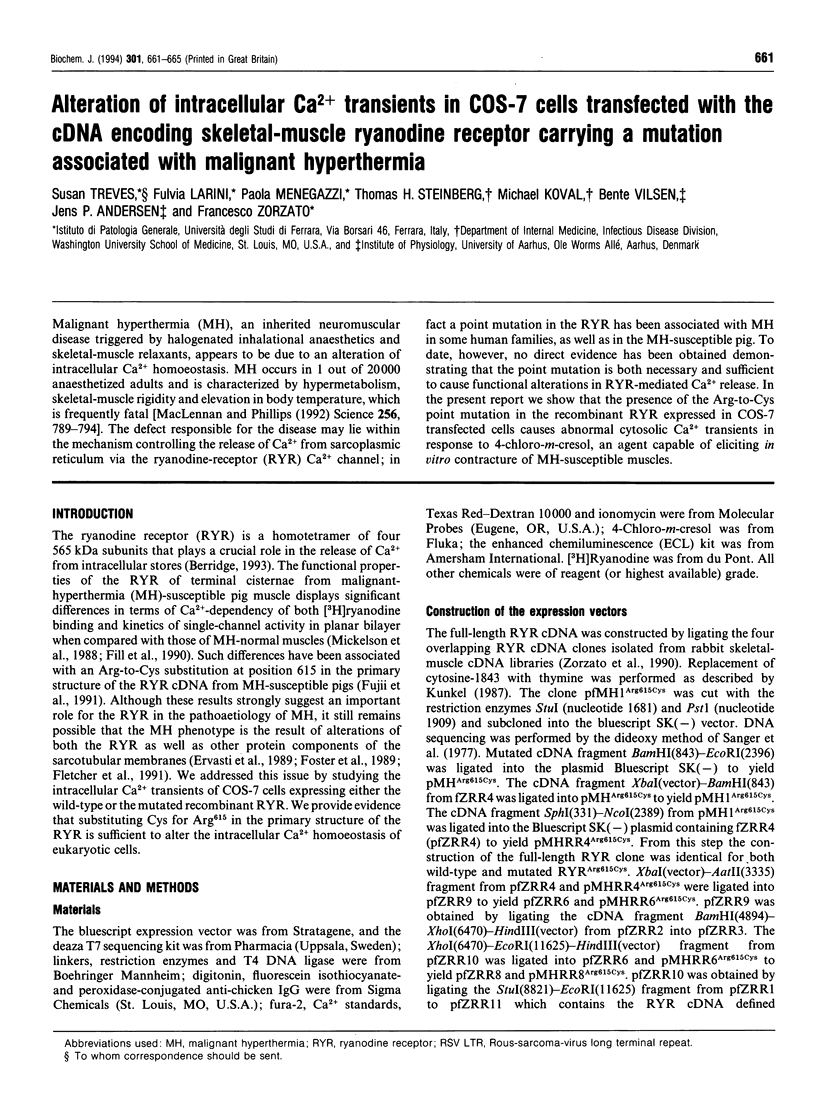
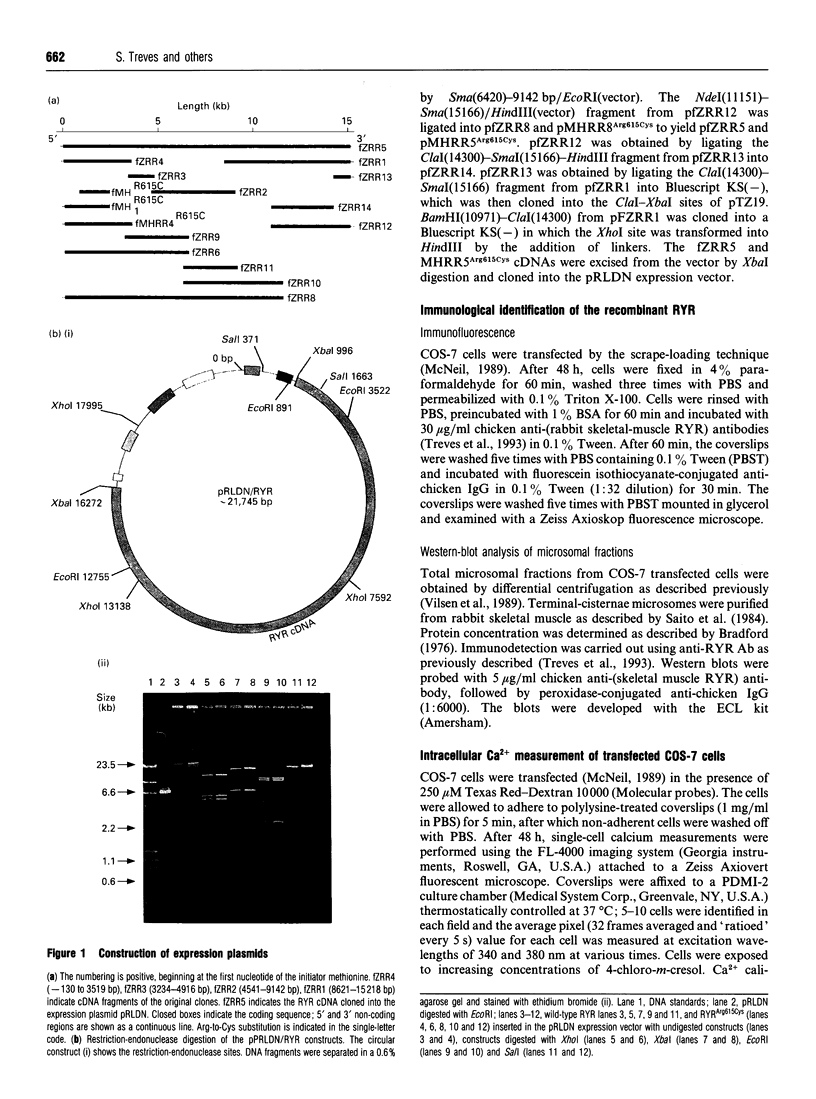
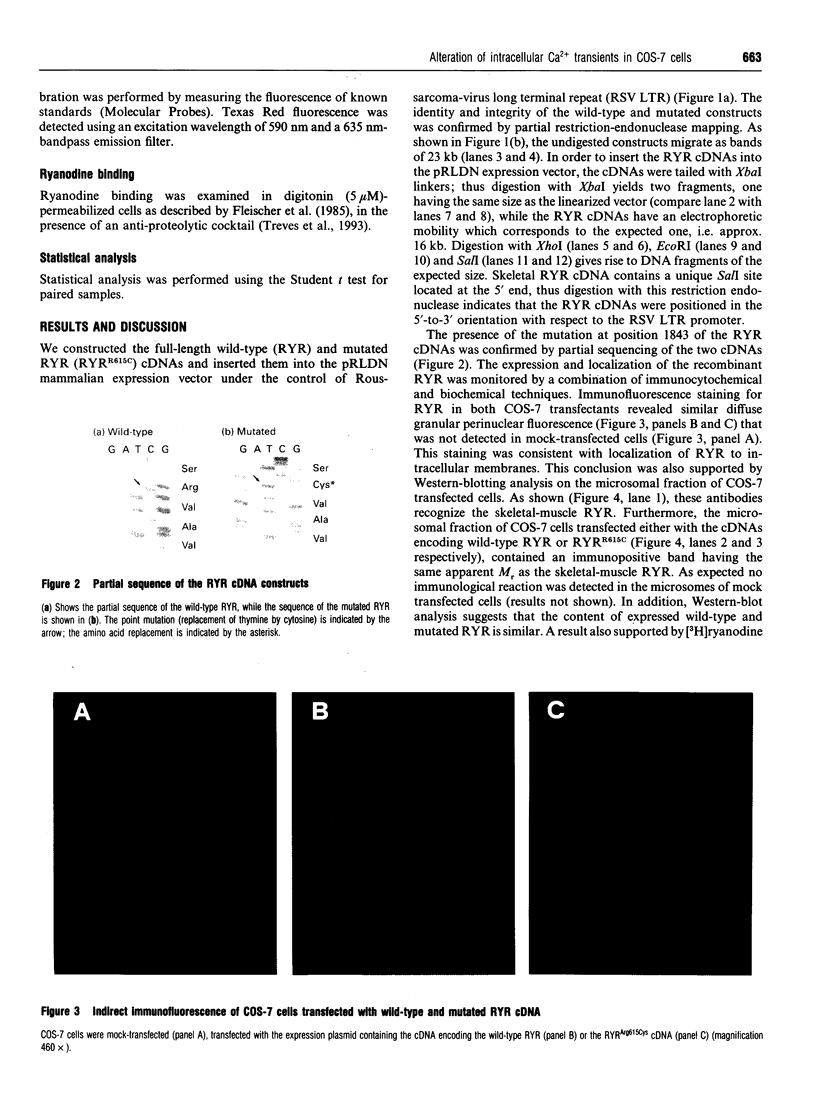
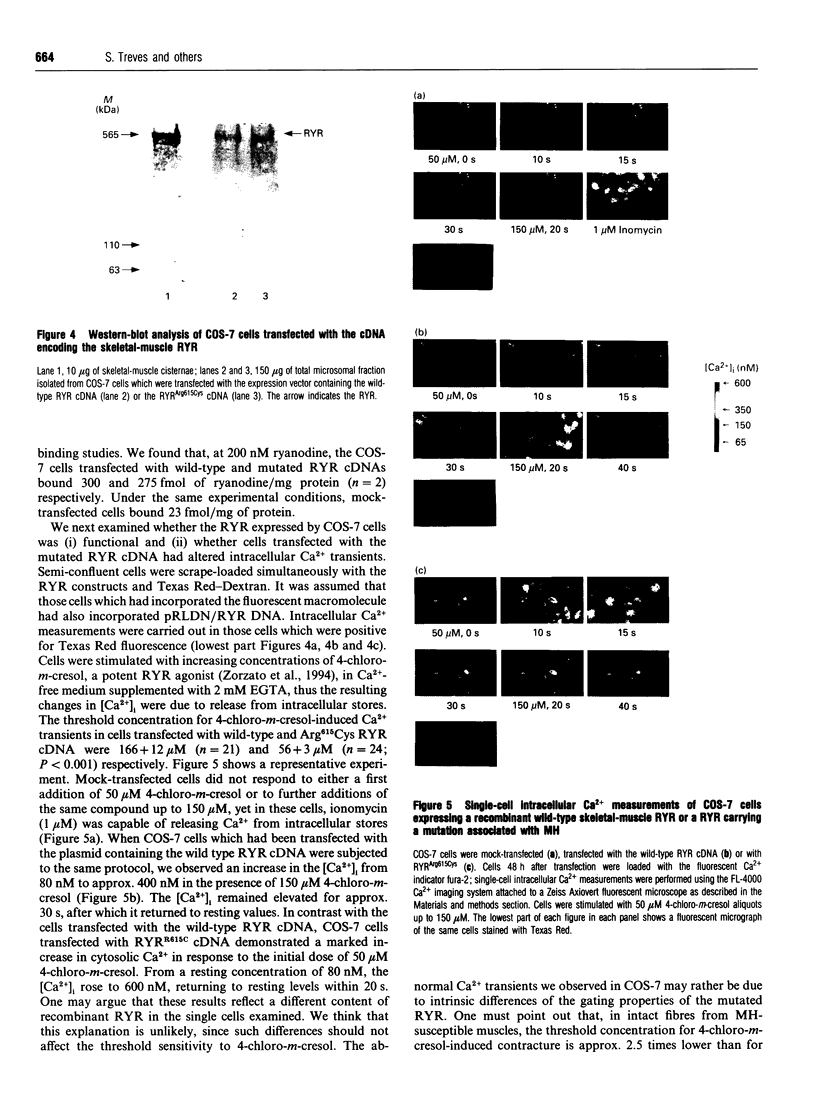
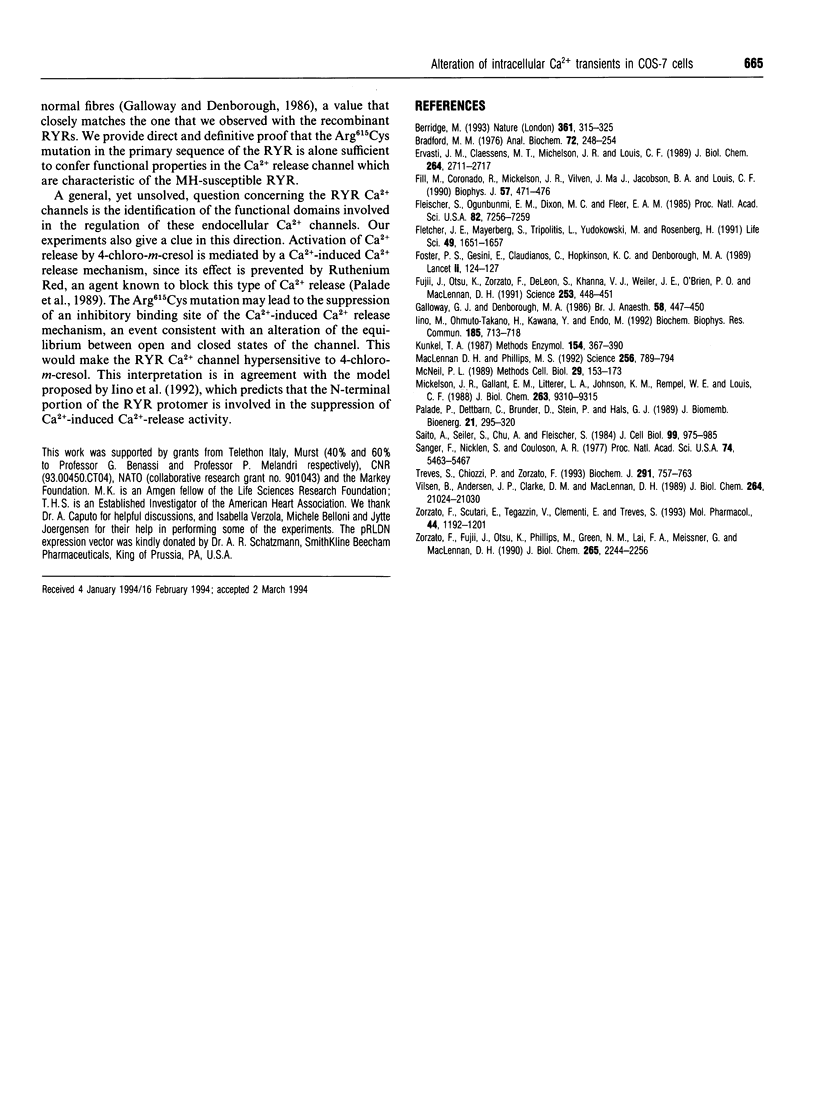
Images in this article
Selected References
These references are in PubMed. This may not be the complete list of references from this article.
- Berridge M. J. Inositol trisphosphate and calcium signalling. Nature. 1993 Jan 28;361(6410):315–325. doi: 10.1038/361315a0. [DOI] [PubMed] [Google Scholar]
- Bradford M. M. A rapid and sensitive method for the quantitation of microgram quantities of protein utilizing the principle of protein-dye binding. Anal Biochem. 1976 May 7;72:248–254. doi: 10.1016/0003-2697(76)90527-3. [DOI] [PubMed] [Google Scholar]
- Ervasti J. M., Claessens M. T., Mickelson J. R., Louis C. F. Altered transverse tubule dihydropyridine receptor binding in malignant hyperthermia. J Biol Chem. 1989 Feb 15;264(5):2711–2717. [PubMed] [Google Scholar]
- Fill M., Coronado R., Mickelson J. R., Vilven J., Ma J. J., Jacobson B. A., Louis C. F. Abnormal ryanodine receptor channels in malignant hyperthermia. Biophys J. 1990 Mar;57(3):471–475. doi: 10.1016/S0006-3495(90)82563-7. [DOI] [PMC free article] [PubMed] [Google Scholar]
- Fleischer S., Ogunbunmi E. M., Dixon M. C., Fleer E. A. Localization of Ca2+ release channels with ryanodine in junctional terminal cisternae of sarcoplasmic reticulum of fast skeletal muscle. Proc Natl Acad Sci U S A. 1985 Nov;82(21):7256–7259. doi: 10.1073/pnas.82.21.7256. [DOI] [PMC free article] [PubMed] [Google Scholar]
- Fletcher J. E., Mayerberger S., Tripolitis L., Yudkowsky M., Rosenberg H. Fatty acids markedly lower the threshold for halothane-induced calcium release from the terminal cisternae in human and porcine normal and malignant hyperthermia susceptible skeletal muscle. Life Sci. 1991;49(22):1651–1657. doi: 10.1016/0024-3205(91)90060-o. [DOI] [PubMed] [Google Scholar]
- Foster P. S., Gesini E., Claudianos C., Hopkinson K. C., Denborough M. A. Inositol 1,4,5-trisphosphate phosphatase deficiency and malignant hyperpyrexia in swine. Lancet. 1989 Jul 15;2(8655):124–127. doi: 10.1016/s0140-6736(89)90182-7. [DOI] [PubMed] [Google Scholar]
- Fujii J., Otsu K., Zorzato F., de Leon S., Khanna V. K., Weiler J. E., O'Brien P. J., MacLennan D. H. Identification of a mutation in porcine ryanodine receptor associated with malignant hyperthermia. Science. 1991 Jul 26;253(5018):448–451. doi: 10.1126/science.1862346. [DOI] [PubMed] [Google Scholar]
- Galloway G. J., Denborough M. A. Suxamethonium chloride and malignant hyperpyrexia. Br J Anaesth. 1986 Apr;58(4):447–450. doi: 10.1093/bja/58.4.447. [DOI] [PubMed] [Google Scholar]
- Iino M., Takano-Ohmuro H., Kawana Y., Endo M. Enhancement of Ca2+-induced Ca2+ release in calpain treated rabbit skinned muscle fibers. Biochem Biophys Res Commun. 1992 Jun 15;185(2):713–718. doi: 10.1016/0006-291x(92)91684-i. [DOI] [PubMed] [Google Scholar]
- Kunkel T. A., Roberts J. D., Zakour R. A. Rapid and efficient site-specific mutagenesis without phenotypic selection. Methods Enzymol. 1987;154:367–382. doi: 10.1016/0076-6879(87)54085-x. [DOI] [PubMed] [Google Scholar]
- MacLennan D. H., Phillips M. S. Malignant hyperthermia. Science. 1992 May 8;256(5058):789–794. doi: 10.1126/science.1589759. [DOI] [PubMed] [Google Scholar]
- Mcneil P. L. Incorporation of macromolecules into living cells. Methods Cell Biol. 1989;29:153–173. doi: 10.1016/s0091-679x(08)60193-4. [DOI] [PubMed] [Google Scholar]
- Mickelson J. R., Gallant E. M., Litterer L. A., Johnson K. M., Rempel W. E., Louis C. F. Abnormal sarcoplasmic reticulum ryanodine receptor in malignant hyperthermia. J Biol Chem. 1988 Jul 5;263(19):9310–9315. [PubMed] [Google Scholar]
- Palade P., Dettbarn C., Brunder D., Stein P., Hals G. Pharmacology of calcium release from sarcoplasmic reticulum. J Bioenerg Biomembr. 1989 Apr;21(2):295–320. doi: 10.1007/BF00812074. [DOI] [PubMed] [Google Scholar]
- Samokyszyn V. M., Miller D. M., Reif D. W., Aust S. D. Inhibition of superoxide and ferritin-dependent lipid peroxidation by ceruloplasmin. J Biol Chem. 1989 Jan 5;264(1):21–26. [PubMed] [Google Scholar]
- Sanger F., Nicklen S., Coulson A. R. DNA sequencing with chain-terminating inhibitors. Proc Natl Acad Sci U S A. 1977 Dec;74(12):5463–5467. doi: 10.1073/pnas.74.12.5463. [DOI] [PMC free article] [PubMed] [Google Scholar]
- Treves S., Chiozzi P., Zorzato F. Identification of the domain recognized by anti-(ryanodine receptor) antibodies which affect Ca(2+)-induced Ca2+ release. Biochem J. 1993 May 1;291(Pt 3):757–763. doi: 10.1042/bj2910757. [DOI] [PMC free article] [PubMed] [Google Scholar]
- Zorzato F., Fujii J., Otsu K., Phillips M., Green N. M., Lai F. A., Meissner G., MacLennan D. H. Molecular cloning of cDNA encoding human and rabbit forms of the Ca2+ release channel (ryanodine receptor) of skeletal muscle sarcoplasmic reticulum. J Biol Chem. 1990 Feb 5;265(4):2244–2256. [PubMed] [Google Scholar]
- Zorzato F., Scutari E., Tegazzin V., Clementi E., Treves S. Chlorocresol: an activator of ryanodine receptor-mediated Ca2+ release. Mol Pharmacol. 1993 Dec;44(6):1192–1201. [PubMed] [Google Scholar]



